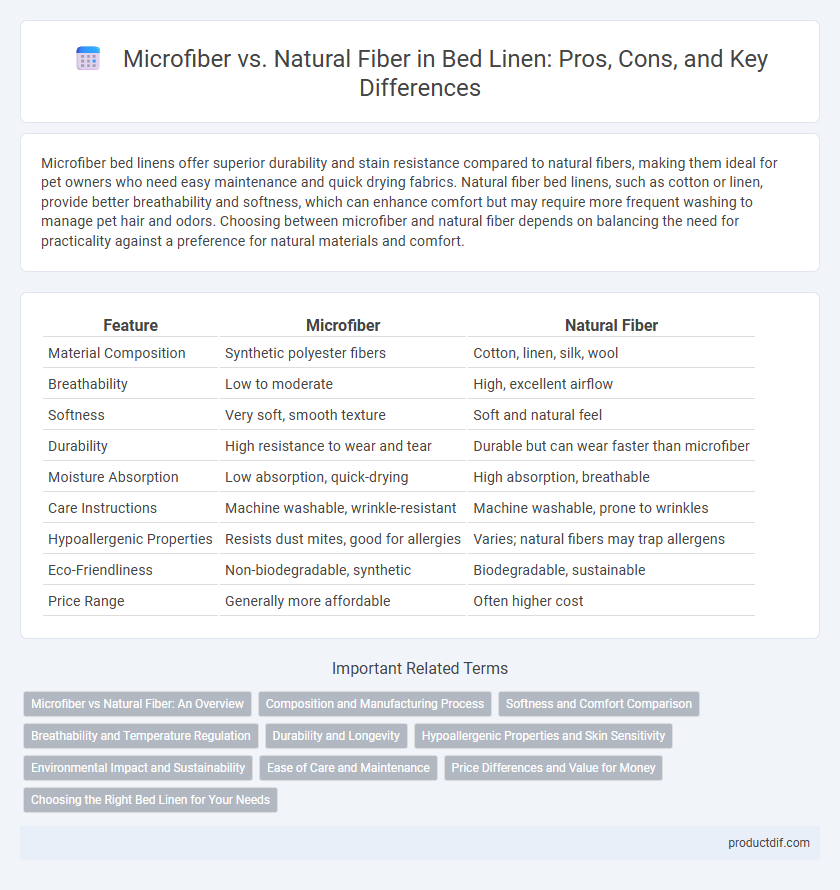Microfiber bed linens offer superior durability and stain resistance compared to natural fibers, making them ideal for pet owners who need easy maintenance and quick drying fabrics. Natural fiber bed linens, such as cotton or linen, provide better breathability and softness, which can enhance comfort but may require more frequent washing to manage pet hair and odors. Choosing between microfiber and natural fiber depends on balancing the need for practicality against a preference for natural materials and comfort.
Table of Comparison
| Feature | Microfiber | Natural Fiber |
|---|---|---|
| Material Composition | Synthetic polyester fibers | Cotton, linen, silk, wool |
| Breathability | Low to moderate | High, excellent airflow |
| Softness | Very soft, smooth texture | Soft and natural feel |
| Durability | High resistance to wear and tear | Durable but can wear faster than microfiber |
| Moisture Absorption | Low absorption, quick-drying | High absorption, breathable |
| Care Instructions | Machine washable, wrinkle-resistant | Machine washable, prone to wrinkles |
| Hypoallergenic Properties | Resists dust mites, good for allergies | Varies; natural fibers may trap allergens |
| Eco-Friendliness | Non-biodegradable, synthetic | Biodegradable, sustainable |
| Price Range | Generally more affordable | Often higher cost |
Microfiber vs Natural Fiber: An Overview
Microfiber bed linens offer exceptional softness, durability, and resistance to wrinkles compared to natural fibers such as cotton or linen, which provide superior breathability and moisture-wicking properties. Microfiber, made from finely woven synthetic polyester or nylon, is more affordable and stain-resistant but can retain heat, making it less ideal for hot climates. Natural fibers, derived from plants or animals, promote better airflow and are often preferred for their eco-friendliness and hypoallergenic benefits.
Composition and Manufacturing Process
Microfiber bed linens are composed of finely woven synthetic fibers, primarily polyester and nylon, engineered through advanced extrusion techniques that create ultra-thin threads enhancing softness and durability. Natural fiber linens, such as cotton, linen, and bamboo, are derived from plant-based sources processed through harvesting, spinning, and weaving, emphasizing breathability and moisture absorption. The manufacturing of microfiber involves high-tech machinery to produce consistent, hypoallergenic fabrics, while natural fibers rely on traditional cultivation and processing methods that contribute to their environmental sustainability.
Softness and Comfort Comparison
Microfiber bed linens are renowned for their ultra-soft texture and lightweight feel, providing exceptional smoothness that retains warmth and resists wrinkles. Natural fibers like cotton and linen offer breathability and moisture-wicking properties, enhancing comfort by regulating temperature and reducing sweat accumulation. While microfiber excels in softness and durability, natural fibers deliver superior air circulation and a more organic touch, making comfort preferences depend on individual sensitivity and climate conditions.
Breathability and Temperature Regulation
Microfiber bed linen offers superior moisture-wicking properties and resists heat retention, making it effective for temperature regulation in warmer climates. Natural fibers like cotton and linen excel in breathability, allowing air circulation that helps maintain a cooler sleeping environment. While microfiber provides durability and quick-drying benefits, natural fibers are preferred for their eco-friendly qualities and enhanced comfort through improved airflow.
Durability and Longevity
Microfiber bed linen offers exceptional durability due to its tightly woven synthetic fibers, resisting wear and tear better than many natural fibers. Natural fibers like cotton and linen, while breathable and soft, tend to degrade faster over time with repeated washing and exposure to sunlight. Choosing microfiber enhances the lifespan of bed linen, providing long-lasting performance and maintaining texture and color after numerous washes.
Hypoallergenic Properties and Skin Sensitivity
Microfiber bed linens exhibit strong hypoallergenic properties due to their tightly woven synthetic fibers that resist dust mites and allergens, making them ideal for sensitive skin. Natural fibers like cotton and linen offer breathability and moisture-wicking benefits, reducing irritation but may harbor allergens if not properly cared for. Choosing microfiber can provide a more consistent barrier against allergens, while natural fibers require regular washing to maintain their hypoallergenic effectiveness for skin prone to sensitivities.
Environmental Impact and Sustainability
Microfiber bed linens, made from synthetic materials like polyester, contribute to microplastic pollution and have a higher carbon footprint due to petroleum-based production. Natural fibers such as organic cotton, linen, and bamboo offer greater sustainability through biodegradability and reduced chemical use, supporting soil health and water conservation. Choosing natural fiber bed linens promotes a lower environmental impact and aligns with eco-friendly consumer preferences.
Ease of Care and Maintenance
Microfiber bed linen offers superior ease of care with wrinkle resistance, quick drying, and machine washability without special treatments, making it highly convenient for daily maintenance. Natural fiber linens like cotton and linen may require gentler washing, slower drying, and occasional ironing to maintain fabric integrity and softness. The durability and stain resistance of microfiber contribute to less frequent deep cleaning compared to natural fibers, which can absorb oils and dirt more readily.
Price Differences and Value for Money
Microfiber bed linens are generally more affordable than natural fiber options like cotton or linen, making them a budget-friendly choice for many consumers. While microfiber offers durability and wrinkle resistance at a lower cost, natural fibers often provide superior breathability and moisture absorption, which can enhance sleep quality. Considering long-term value, natural fiber bed linens may justify their higher initial price through increased comfort and longevity, appealing to those prioritizing investment in sleep health.
Choosing the Right Bed Linen for Your Needs
Microfiber bed linen offers exceptional softness, durability, and wrinkle resistance, making it ideal for those seeking low-maintenance and budget-friendly options. Natural fibers like cotton, linen, and bamboo provide superior breathability, moisture-wicking properties, and hypoallergenic benefits, perfect for sensitive skin and warmer climates. Selecting the right bed linen depends on prioritizing factors such as comfort, breathability, ease of care, and personal sensitivity to materials.
Microfiber vs Natural fiber Infographic

 productdif.com
productdif.com